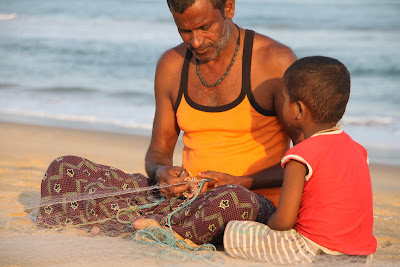Luckshmi Sivalingam, Program Officer within SfP, overseas the Livelihood Pathways for the Poorest (LPP) project at Grameen Foundation and has been working with the field team in Gaya since April of 2010 to design the livelihood and financial products, services and methodology comprising the integrated livelihoods model.
Grameen Foundation’s Solutions for the Poorest program has been working since last year to implement its own “ultra-poor “program , which takes inspiration from the BRAC graduation model, Fonkoze’s Ti Kredi program, and BASIX’s Livelihood Triad Strategy, as well as social enterprises that are experimenting with models to reach poor AND poorest households sustainably. The model we are testing – the ‘Integrated Livelihoods Model for the Poorest’ – combines financial services and livelihood support, sequentially providing these services to our target households as they gain confidence and momentum in the program. Our services are designed to have some measure of cost recovery as we aim to build a program that makes business sense for a double bottom line institution to implement.
The current pilot – dubbed “Livelihood Pathways for the Poorest” – is operating in partnership with BASIX India’s The Livelihood School (TLS), in Gaya district in the Indian state of Bihar and is reaching two hundred very poor households. We designed and implemented a composite targeting tool to ensure the inclusion of households currently excluded from microfinance services and government social welfare schemes. Another fifty households of similar demographics are being monitored to make a comparative assessment of the impact of the products and services against a set of socio-economic indicators.
Developing a process to define and identify who the poorest are was a challenging one. Who are the “very poor”? What does poverty look like in their context, and what are its propagators? What are the needs of the very poor to propel them on a pathway out of poverty? It seems like it was only yesterday that I was in Gaya for the second time, working closely with the BASIX TLS team, trudging through our target villages to design and implement a targeting methodology to help us identify the poorest households and help us answer some of these key questions. Last August, our team of three slogged through kilometers of muddy or flooded lanes through villages absent of sewage and waste management systems. The monsoon rains, albeit short-lived, were particularly heavy those few days we worked to test the targeting process with a sample group of the target population before the final process would be scaled up across the entire project area.
We began by holding a community meeting to share the project goal and objectives with the entire village and its leaders before engaging in Participatory Wealth Ranking (PWR), an interactive and inclusive method of rural appraisal, whereby the community members themselves define what poverty means in their own context and categorize individuals according to local definitions. Shortlisted households in the bottom wealth category were visited individually and further surveyed to collect the Progress out of Poverty Index® (PPI®) score, a tool commissioned by Grameen Foundation to determine the likelihood of a household or individual falling above or below a specified poverty line. A household survey also captured a range of data, including their cash flow, livelihood portfolio, food security, health, and other indicators. The final data was measured against selection criteria that helped us identify the poorest households in a given community.
Such a multilayered filtering process ensures that interventions are reaching households not only living on less than $1.25/day, but also well below localized definitions of poverty. While an institution can target clients of varying poverty levels, the products and services it offers must be customized to meet the unique needs of these clients. Poverty targeting can strengthen market research outcomes and better inform institutions on how to service different gaps through appropriately designed products and services. In the case of the ‘Livelihood Pathways for the Poorest’ pilot project, this understanding proved invaluable in executing subsequent key activities such as product and service design and identification of viable delivery mechanisms.
For more information, you can refer to the full use case on this process here or on Grameen Foundation’s Solutions for the Poorest website.








































































































